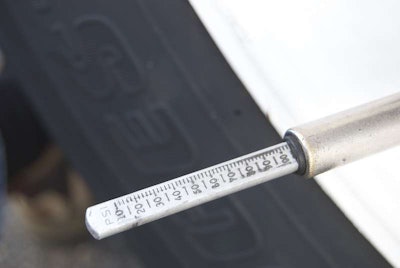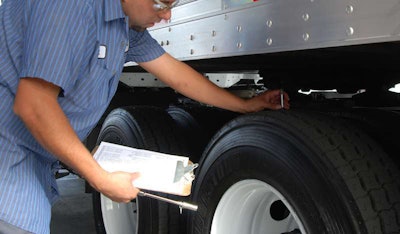 110 psi is the most commonly-accepted pressure for a steer axle with a 12,000-lb. rating. Drive and trailer tire pressures vary, with most drivers opting for about 85 psi.
110 psi is the most commonly-accepted pressure for a steer axle with a 12,000-lb. rating. Drive and trailer tire pressures vary, with most drivers opting for about 85 psi.It’s a scene played out countless times a day: A truck driver climbs into his cab and cranks his rig. While the big diesel is warming up, he reaches down behind the seat or into the storage space in the door and pulls out a heavy wooden club. He climbs out and walks around his rig, thumping each tire along the way to ensure they have the proper air pressure.
According to industry experts, he’s wasting his time.
“When I see a truck driver walking around thumping their tires, I tell them they might as well take that stick and whack the hood of their truck to see if it needs oil,” says Harvey Brodsky, managing director of the Retread Tire Association. “That’s how accurate a tire thumper is.”
William Estupinan, vice president of technical service for Giti Tire USA – which markets and sells GT Radial commercial tires in North America – is somewhat more generous discussing tire thumpers, but just as dubious as Brodsky.
“If you think you have a ‘well-calibrated’ ear, thumping the tires could possibly give you an idea of the difference in pressure between one tire and the other, but it will never tell you the actual air pressure,” he says. “And the typical sound of a tire at a particular pressure will be different if the tire is hotter.”
 Running tires under-inflated by only 10 percent can reduce fuel economy by 1 percent.
Running tires under-inflated by only 10 percent can reduce fuel economy by 1 percent.Furthermore, Estupinan says, it doesn’t take much variation from optimal pressure to produce serious problems. Consider:
- A difference of only 10 percent in air pressure between duals can cause enough variation in diameter to produce irregular wear in both tires.
- For every 10 percent of underinflation, a 1 percent reduction in fuel economy will occur. While that might seem low, it adds up when considering tire positions and miles run per year.
- Running a tire constantly underinflated by 20 percent will reduce tread life by 30 percent.
- Running at 40 percent underinflation will reduce tire life by 50 percent.
“That’s not to mention factors like irregular wear, higher thermal and mechanical fatigue of the casing, lower retreadability and even premature failure,” Estupinan says.
So even if a thump is close, it’s not good enough to determine if a tire is inflated safely enough to carry a load. The only acceptable and reliable way to check tire pressure, Brodsky says, is by using a calibrated tire gauge at least once a week.
HOW TO USE A CALIBRATED GAUGE:
- BUY THE RIGHT GAUGE. A calibrated gauge will cost about twice as much as a lower-quality $10 gauge.
- FIND A MASTER GAUGE. Most tire stores have master gauges and will let truck drivers check their calibrated gauges against it for free, which beats buying a master gauge for as much as $100. For help locating a dealer with a master gauge, contact the Retread Tire Organization toll-free at 888-810-8861 for a packet of information on how and where to buy calibrated gauges and how and where to check their accuracy. The packet is free to truck drivers.
- CHECK THE CALIBRATED GAUGE’S READING. If it differs from that on the master gauge, use the calibrated gauge’s adjustment screw to adjust its pressure reading to match the master gauge.
Getting in the habit of putting a gauge on a value stem can be a tough adjustment for busy truckers.
“Considering the old saying that time is money, the time saved by not inspecting the tires, about 20 to 30 minutes, with a gauge but rather with a thump will be more than lost in the monetary terms of irregular wear, reduced wear life and even losing the tire if the air loss is caused by a puncture,” Estupinan says.
Once a driver is in the habit of checking tire air pressure regularly, his next goal should be to determine the optimum pressure required for his operation.
Steer tire pressure is most critical, says Guy Walenga, Bridgestone/Firestone’s director of engineering for commercial products and technology. Walenga and Doug Jones of Michelin Americas Truck Tires offer these tips:
HOW TO ESTABLISH IDEAL PRESSURES
- SET STEER TIRE PRESSURE at 110 psi on a 12,000-pound front axle.
- SET DRIVE AND TRAILER TIRE PRESSURE within a broader allowable range. The legal load rating is only 75 psi for those tires. Most truckers settle between 85 psi and 105 psi, with 95 psi being the most common. Those pressures are well above legal load settings.
- DON’T OVERCOMPENSATE FOR TEMPERATURE. Changes in temperature rarely create a problem for properly inflated tires. A 30-degree drop typically will cause only a 2-psi drop in tire pressure. If starting a trip in Miami where it’s 80 degrees and heading to Minnesota where it’s 10 below zero, the 6-psi loss is not an issue when beginning at a good inflation level.
- DON’T OVERCOMPENSATE FOR CHANGES IN GROSS VEHICLE WEIGHT. Taking on or delivering a load, even when dealing with 80,000 pounds, shouldn’t be a concern. Moving beyond 80,000 pounds might require more pressure. If necessary, check the tire manufacturer’s load and inflation charts on its website or in its data book or service manual.
- UNDERSTAND HAZARDOUS ROAD CONDITIONS. Faced with an emergency surface situation – usually snow, ice, mud or sand – it might be necessary to lower air pressure to extend the tire footprint and increase traction. Increase tire pressures back to the preferred settings as soon as the emergency has passed.









